High quality digital and litho printers in Colchester
What binding options are there for my book?
You have the choice of two binding options for your publication - wire stitching or perfect binding.
Which one you go for is primarily dictated by the number of pages,
but also thickness of stock and personal aesthetic preference.
Bound with
2 staples
Wire Stitching
For upto
40 pages
Wire Stitching
(also known as 'Saddle Stitching')
This is the best method for binding lightweight magazines.
The printed sheets are sorted with the cover at the top of the stack, centre spread at the bottom, then folded in half and bound together using two staples on the spine.

Recommended for upto 40 pages
This process is only recommended for booklets upto 40 pages.
If you have more pages than 40 then the thickness when folded in half will cause your booklet to ‘bounce’ open when laid flat rather than staying closed.
Wire stitching more than 40 pages causes stress on the staples and they could rip or fall out when the booklet is read.
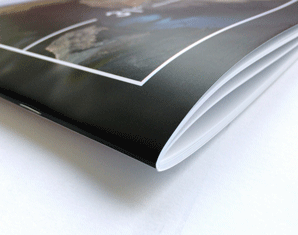
Thick covers can crack when folded
On thick silk and uncoated stocks (200gsm+) the paper fibres can crack when they are folded (as shown here on the right). The black ink has disintegrated when the covers were folded and left scuffing along the spine where the paper shows through.
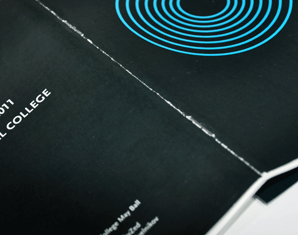
Laminating prevents cracking
We recommend matt or gloss laminating the outside of covers printed onto 200gsm or thicker. Lamination gives the sheet more protection and prevents the ink from cracking.
Our example here on the right has full black coverage on a 350gsm silk cover but because it is matt laminated the ink hasn't cracked unlike the image above.
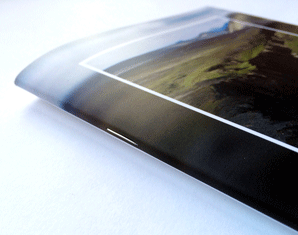
Design Considerations
In thicker wire stitched booklets the inside pages are pushed further out (away from the spine) when they are folded. The image to the right shows this. Therefore when they are trimmed, the pages nearer the centre of the book become shorter the nearer the middle of the book they are - referred to as 'creep'. It is a very good idea to keep any page numbers and important information 5mm away from the page edges. The slight change in page width will also mean any repeating patterns or objects intended to be in the same position on every page won't be and will show some variation as you flick through the book.
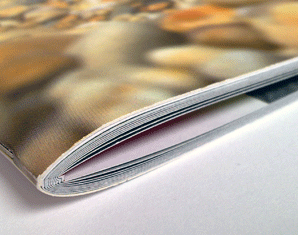
Does your artwork work as a booklet?
You need a multiple of four pages for wire stitched booklets. When you fold a sheet of paper in half to staple the spine you get four pages - two on the outside, two on the inside.
So, we need 8, 12, 16, 20, 24, 28, 32, 36 or 40 pages to make a booklet. We can't do a 21 page booklet because you would end up with one loose page.

Best for
over
40 pages
Perfect Binding
Laminate outer cover
Glue
bound with
a square
spine
Perfect Binding / PUR Binding
Perfect binding gives the project a more book-like appearance.
We would recommend perfect binding for booklets of 40 pages or more, or publications that have a width of more than 3mm. (Increasing the weight of your text pages will make the spine thicker. However, we don't recommend choosing thicker than 170gsm for text pages because the pages become too rigid to turn and read).
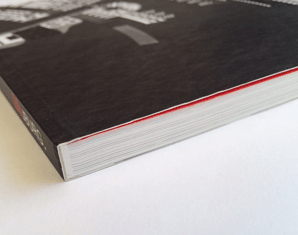
How does it work?
In the Perfect Binding process all the pages are trimmed to size and stacked in a block. The left hand edge of your inside pages are aligned on the spine side, roughened up before a strong glue is applied. The cover is (laminated if required) creased to form a hinge, wrapped around the text block and then glue bound on to give a square finish on the spine.
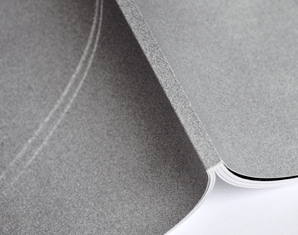
Why does my quote say a '4pp Cover'?
Your cover is made up of 4 pages: a front cover, a back cover aswell as an inside front and back cover.
All of these are printed onto your chosen cover stock making a 4pp cover.
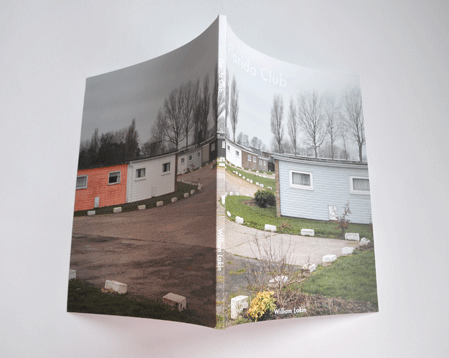
How easy is it to open the cover?
We crease a 'hinge' onto your front and back cover (see image to the right). This is around 5mm from the spine and allows the cover to open more easily without tearing your text pages. To give the hinge extra strength it is glued onto the first and last text page. This means you lose around 10-12mm on those pages where the cover is glued so avoid placing any important content (text, logos etc) in those areas.
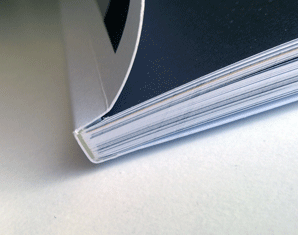
How thick will my spine be?
The more inside pages your book has, the thicker the spine.
You can find our most popular spine sizes by clicking here.
As a guide, 48 inside pages onto 120gsm uncoated would be
a 3.9mm spine, 60 inside pages equals a 4.8mm spine and 100 inside
pages would give you a 7.9mm spine.
If the spine is less than 3mm (40 pages) we suggest you go for wire stitching instead because there won't be enough surface area to glue.
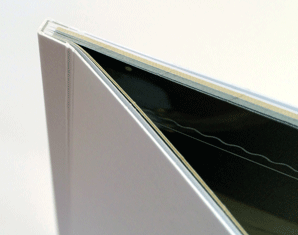
Can I put text on my spine?
Yes you can!
But if your spine is less than 5mm we advise NOT putting text on it. This is because our presses have a 1mm tolerance and paper is after all a natural material which can shrink and expand during printing. The image to the right shows what
can happen if you have a solid background colour or large
text on the spine - this can slide round to the cover so is best
to keep text well away from the spine edge.
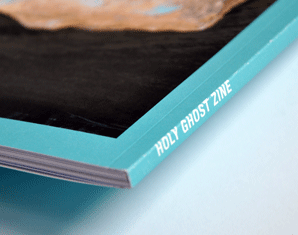
I have images that go across a spread will some of the image be lost in the middle?
Unfortunately yes, but there is a way round this (read on...).
The 'spine gutter' is the section of a page immediately next to the spine which becomes obscured during binding. This happens when the pages are glued quite tight and become hard to press completely. You lose 3-4mm in the spine side of each page. The line on the 'filthy' example here should run smoothly across the centre spread but 3mm is lost on the left AND the right hand pages in the gutter and the line actually appears jagged.
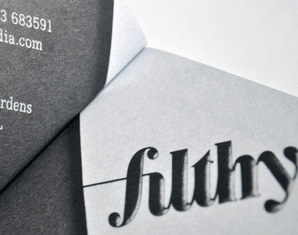
How to solve the spine gutter issue
The good news is that you can overcompensate for the spine gutter by sliding the left hand page’s image 4mm left and the right hand page's image 4mm to the right.
This isn't an exact science but will give the illusion that the image matches up in the middle.

What about text that crosses a spread?
It is never a good idea to put text, particularly small text,
across a spread because when some of the text is lost in the spine gutter the words or sentences will be incomplete and
will no longer make sense.
Moving any important text a good 6-8mm away from the spine will make it readable without challenging people to force the pages flat. (This will also risk cracking the spine).
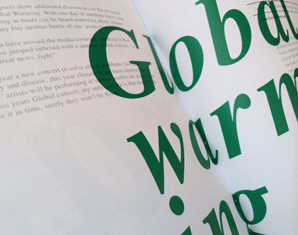
We don't just deliver in Colchester
Check out www.exwhyzed.co.uk for
Booklet Printing
Business Card Printing
Leaflet Printing
Poster Printing
Self Published Book Printing
Zine Printing
Contact Us
tel: 01206 766647
email: colchester@exwhyzed.co.uk
web: www.colchesterprinter.com
and www.exwhyzed.co.uk
© Ex Why Zed 2016
All rights reserved. No reproduction without permission -
use some brain cells and write your own content!
Check www.exwhyzed.co.uk for...
Annual Report Printing
Architecture Study Book Printing
Artist Catalogue Printing
Booklet Printing
Business Card Printing
Degree Show Catalogue Printing
Digital Printing
Final Major Project Printing
Leaflet Printing
Newsletter Printing
Portfolio Printing
Poster Printing
Self Published Book Printing
Stationery Printing
Sticker Printing
Zine Printing